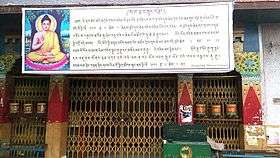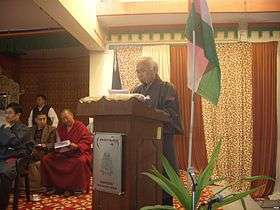Majnu-ka-tilla

| Majnu-ka-tilla New Aruna Nagar Colony, Samyeling | |
|---|---|
| Neighbourhood | |
|
View from rooftop in Majnu-ka-tilla | |
 Location of Majnu-ka-tilla in Delhi | |
| Coordinates: 28°42′05″N 77°13′41″E / 28.70137°N 77.22816°ECoordinates: 28°42′05″N 77°13′41″E / 28.70137°N 77.22816°E | |
| Country |
|
| State | Delhi |
| District | North Delhi |
| Established | 1960 |
| Population (2000)[1] | |
| • Total | 2,500 |
| Time zone | Indian Standard Time (UTC+5:30) |
| Pincode(s) | 1100054[2] |
| Area code(s) | +91 11 |
Majnu-ka-tilla (MT) is a Tibetan colony in Delhi, India that was established around 1960.[note 1] Majnu-ka-tilla is officially called New Aruna Nagar Colony,[5] Chungtown,[3] and Samyeling.[6] It is part of North Delhi district and is located between the Yamuna River and Delhi's Outer Ring Road (NH-1) near ISBT Kashmiri Gate.
History
The historic name of area, literally means the hillock of Majnu, after the tilla or mound where during the reign of Sikandar Lodhi (r. 1489–1517) on Delhi Sultanate, a local Iranian Sufi mystic, Abdulla nicknamed Majnu (lost in love), met Sikh Guru, Guru Nanak on July 20, 1505. Majnu ferried people across the Yamuna river for free as a service to God, his devotion resulted in the Nanak staying here till end July. In later history Sikh military leader Baghel Singh built the Majnu ka Tila Gurudwara to commemorate the stay in 1783, and the sixth Sikh guru, Guru Har Gobind also stayed here. Today it is one of oldest extant Sikh shrines in Delhi and the surrounding estate of donated by early 19th-century Sikh emperor, Ranjit Singh.[7][8][9]
Majnu Ka Tilla area has three main residential settlements with total 3000–3500 homes, Aruna Nagar, New Aruna Nagar and Old Chandrawal village, which was built up in early 1900s, when British government settled labourers involved in the construction of the Central Secretariat buildings, during the construction of the New Delhi. The next round of settlement came post-independence in 1958-59, when Aruna Nagar was developed by the Land and Development wing of the Ministry of Urban Development as it disburses 925 plots of 40 sq. yard each, to people resettled here from various part of North Delhi. The Tibetan refugee camp later named New Aruna Nagar developed after 1960, and more recently two large jhuggi jhopari (hutment) clusters have developed on the periphery.[9]
Tibetan settlement: 1960 to present
Just as Aruna Nagar was developing, the 1959 Tibetan uprising took place in March, most residents of Majnu-ka-tilla left Tibet in 1959-60, when the Dalai Lama too went into exile to Dharamsala. Soon, a small Tibetan refugee camp up across the road, on the Yamuna riverbed.[1][9] The land was allotted by the Government of India to the refugees in 1960.[10] After the Sino-Indian War in 1962, many of the refugees who had previously settled temporarily near the Indo-Chinese border shifted here.[9] Today, it is home to second generation of Tibet refugees and is also known as Samyeling, through colloquially as "Little-Tibet" or "Mini-Tibet".[11][12]

The legal status of Majnu-ka-tilla has previously come into dispute. In 1995, residents were "given a formal assurance from the Centre" that they would be allowed to remain at the site until the international dispute over Tibet was settled.[4] In June 2006, the colony was served a court-issued notice indicating that it would be demolished in connection with the Delhi government's road expansion and Yamuna River beautification plan.[13][14] At least two buildings were demolished in connection with this order.[6] As of 2012, however, a court order had avoided eviction, regularising the status of the colony.[15][16]
The colony, officially known as New Aruna Nagar Colony, remains unauthorised,[2][17] though in March 2013, Government of Delhi included New Aruna Nagar (Tibetan refugee camp) in its list of 895 "to-be-regularised colonies".[9] The refugee colony experienced widespread flooding in 2010 rainy season, as a result many of the residents took reinforcement measure in their buildings.[18] On June 20, 2013, during the North India floods, the Yamuna river breached its banks and inundated numerous houses in the low-lying area. They remained partially submerged for several days, and people shifted to upper floors or to relief camps. The floods also lead to power outages and water shortages, raising concerns of health hazards.[19][20][21]
Economy
The economy of Majnu-ka-tilla centres around hotels, guest-houses and restaurants.[6] Another important aspect of the economy is home rentals as a large population is cramped in closely built houses, several floors high and approachable through narrow bylanes.[9] In addition, there is a market of retail stalls, including bookshops, curio shops, metalsmiths, and a beauty parlour; internet cafes, and travel agencies.[3][6] The neighbourhood is popular among foreign and domestic tourists as well as among Delhi University students.[3]
Tourism
Over the years, New Aruna Nagar (Tibetan refugee settlement) has emerged as popular destination for foreign tourists and students from North Campus of Delhi University. It houses a small monastery and Buddhist temple, besides numerous restaurants specialising in Tibetan cuisine, curio shops selling Tibetan handicrafts and stores selling the latest fashionwear and gadgets.[9][12]
Demographics
The colony had approximately 2,500 residents in 378 family groups as of 2000.[1] Residents have strong ethnic identification: in one survey of young adult recent arrivals from Tibet and young adult children of Tibetan refugees in Majnu-ka-tilla, all identified as 100% Tibetan, nearly all wanted to marry Tibetans, and around 60% said that 80% or more of their friends were Tibetan.[1]
Administration
Administratively, it falls under the Civil Lines subdivision of the North Delhi district of NCT Delhi.[2]
- REDIRECT [[]]
Transport
The area lies on a stretch of the National Highway 1, which is part of the historic Grand Trunk Road and the Outer Ring Road of Delhi. It is at a walkable distance from ISBT Kashmere Gate. It is approachable through the Kashmeri Gate station of the Delhi Metro, lies on both the Red (Dilshad Garden -Rithala) and Yellow Lines (Samaypur Badli - HUDA City Centre)[22]. It is a transfer station between the Red Line on the highest upper level and the Yellow Line on the lowest level.[23] The Vidhan Sabha metro station is 1.5 km away.[9]
See also
Notes
- ↑ Express India writes that it was founded in 1959,[3] while The Times of India writes that it was founded in 1962.[4]
References
- 1 2 3 4 Klieger, Paul Christiaan (2002). "Engendering Tibet: Power, Self, and Change in the Diaspora". In Paul Christiaan Klieger. Proceedings of the Ninth Seminar of the IATS, 2000 - Tibet, Self, and the Tibetan Diaspora: Voices of Difference. Brill Publishers. pp. 142–145, 149. ISBN 978-90-04-12555-1.
- 1 2 3 "List of applicant unauthorized colonies: Sl. no.106, rgn no. 111" (PDF). Govt. Of NCT. Of Delhi, Urban Development Department. Retrieved June 25, 2013.
- 1 2 3 4 Yambem, Miranda; Amrita Tripathi. "Footloose in Little Lhasa". Indian Express. Retrieved January 4, 2005.
- 1 2 Sharma, Nidhi (August 5, 2006). "Majnu ka tilla eviction issue: Govt won’t give up on 'Little Tibet'". Times of India.
- ↑ "Get a taste of Tibet in Delhi". Hindustan Times. March 19, 2006.
- 1 2 3 4 Samphel, Thubten (September 13, 2006). "Dharamshala diary: Majnu Ka Tilla re-visited". TibetNet. Central Tibetan Administration. Retrieved November 20, 2012.
- ↑ "A Gurdwara steeped in history". The Times of India. Mar 25, 2012.
- ↑ "Majnu ka Tila and the romance of sepak takraw". Indian Express. Jul 28, 2011.
- 1 2 3 4 5 6 7 8 "Happiness and discontentment". Hindustan Times. March 19, 2013. Retrieved 25 June 2013.
- ↑ "Suggestion of Masterplan Review 2021 (RWA Letter)" (PDF). Delhi Development Authority (DDA). Retrieved June 25, 2013.
- ↑ Jayashree Nandi (May 15, 2013). "Lull before Li storm in ‘Little Tibet’". The Times of India. Retrieved 25 June 2013.
- 1 2 Isha Gupta (June 18, 2011). "Delhi’s mini Tibet: Majnu Ka Tilla". Hindustan Times. Retrieved 25 June 2013.
- ↑ "Majnu-ka-tilla finally gets court notice on demolition". Phayul. June 15, 2006.
- ↑ Dickyi, Tenzin (September 8, 2006). "Can we still save Majnu-ka-tilla?". Phayul.
- ↑ "Delhi court order brings relief to Tibetans". Central Tibetan Administration. September 17, 2012. Retrieved November 20, 2012.
- ↑ "Delhi Tibetan colony to be regularized". Voice of America Tibetan. August 26, 2012. Retrieved November 20, 2012.
- ↑ "Unauthorized Colonies under the jurisdiction of Government of NCT Delhi". Govt. Of NCT. Of Delhi Urban Development Department. Retrieved June 25, 2013.
- ↑ "3 yrs on, flood in mini Tibet". The Times Of India. Jun 20, 2013. Retrieved 26 June 2013.
- ↑ "Water recedes, disease threat looms". The Times Of India. Jun 21, 2013. Retrieved 26 June 2013.
- ↑ "Delhi: Yamuna continues to flow over danger mark". Hindustan Times. June 20, 2013. Retrieved 26 June 2013.
- ↑ "Health hazards loom large". DNA India. Jun 24, 2013. Retrieved 26 June 2013.
- ↑ http://www.mapsofindia.com/maps/delhi/delhi-metro-yellow-line-map.html. Missing or empty
|title=(help) - ↑ "Station Information". Archived from the original on 2010-06-19.
- Map of Majnu Ka Tila Govt. of Delhi
www.majnukatilla.com
